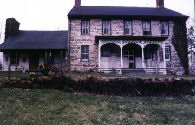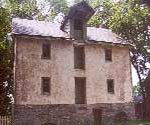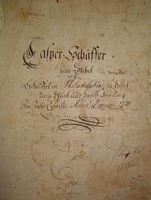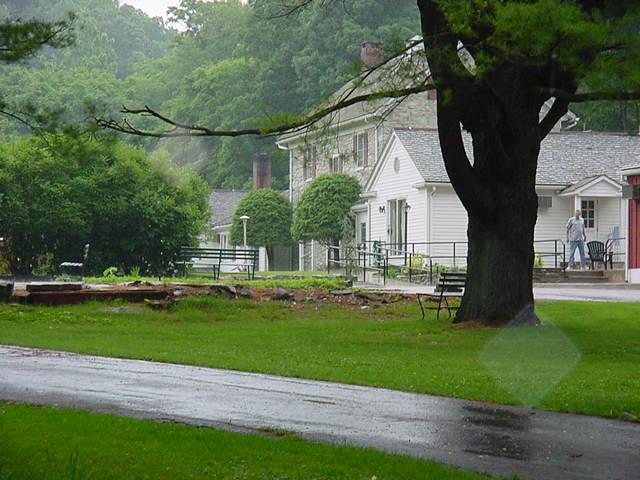W hat an excellent example our first family set for us. His grandson said of him,"he was a man naturally of a strong mind, of strict integrity, not lacking in sagacity, of great industry and indomitable perseverance, guided in all his actions by a principle of moral rectitude; a strict disciplinarian, and rather intolerant of what he believed to be wrong." He had a religious zeal, and was very motivated for high achievement in every endeavor. He saw a need for a grist mill, so he built one. As soon as he had the capacity to make more flour than what he need he established a trade route to distant cities. Additionally he found the time to travel to various sites to represent the people. The fact that he had not acquired a command of the English language did not slow him down.
He was reportedly one of the strongest men in Stillwater. How did he get so strong you ask. He was a farmer who toiled in the soil. Surely, if you know any farmers you have observed their great strength. Additionally, as a miller, he constantly carried large bags of grain up and down the stairs to and from the second and third levels of the mill.
I am reminded of the story about his house being completely surround by Indian who were definitely on the war path. Being alone at the time Casper believed he had better go get some reinforcements. As he dashed across the field to get his brother-in-law, George Wintermute's assistance an Indian was close on his heels. Casper turned and in a moment had thrown the Indian to the ground, and left him prostrate on the ground by tying him up with one of his garter's.
So precious little is known of Casper's wife, our 5th great grandmother. All that we have is the recordings of her grandson, Doctor Casper Schaeffer in the Memories and Reminiscences book. He states: My grandmother Schaeffer had received an education somewhat above the ordinary standard of her day. She was of refined taste and cultivated manners, as well as exemplary piety. She was overheard explaining that she had read her German bible through three times since her "old man's death."
Then, ten years had gone by since his death, this being near the close of her life. She had bought with her from Germany what was rare in those days, many rich silk dresses, embroidery, jewelry and trinkets, which were carefully preserved as keepsakes during her life, carefully locked up in chest and casket. But in the lapse of time and over tunings, these relics have all unhappily become squandered.
Casper's Original Home.
Casper Schaeffer was born about 1711 some where in the Palatinate region of Germany. I believe he was born and raised somewhere near the vicinity of Worms. I will explain my reasoning for this belief next.
It is recorded on Johan Peter Bernhardt's tombstone (Casper's father-in-law) that he was born in Kzenheim, County of Bolanden. Kerzenheim is located South West of Worms. Similarly, it is known that John Georg Windermuth ( Casper's brother-in-law) was from Pfungstadt, which is located North East of Worms. The exact location of Casper origin in Germany is unknown to us. However his grandson, whose notes became the book " Memoirs and Reminiscences" theorized that the Schaeffers, Windermuth, and Bernhardts were all from the same general area and knew each other in Germany.
Reasons for leaving.
Wars, famine,severe winters and a strong desire for freedom all contributed to his decision to leave his family and come to this land so far away.
The Route.
He traveled down the Rhine to Rotterdam in the Netherlands, then sailed from Rotterdam to Deal, England. Later, he continued from Deal, England to Philadelphia, Pennsylvania. He was 27 when he arrived at Philadelphia on the 16th of September, 1738 on the ship "Queen Elizabeth." Alexander Hope was the Master.
The spelling of our name.
Ourimmigrant grandfather originally used the German spelling of the family's name, Schaeffer. However, immediately upon docking in Philadelphia, the spelling was phonetically altered to Shaver by those who documented his arrival. He and his three sons, and most of their descendants accepted that spelling (Shaver or Shafer) through out their life times.
However, one grandson, Rev. Casper Schaeffer, M.D., was opposed to this change to the American way of spelling. He very strongly advocated that the entire family should revert to the old German spelling, as he had done.
Obviously, his father, Abraham, did not share those feelings. Of special interest is the fact that as late as 1820 he was identified as Doctor Casper Shaver in his father's will.
A few of the descendants did change the spelling to Schaeffer or Shaffer. But, by far, the most common spelling today, of Casper Shaver's descendants is Shafer.
It should be noted that during this period of time, people could change their name simply by writing it the way they wanted it to be. Unlike today when name changes must go through a very formal and controlled procedure.
1738~1741
Casper Shaver'sactivities are unknown for the period between his arrival in Philadelphia, PA (in 1738) and his arrival in Stillwater, NJ. (about 1741) He may have been working in servitude to pay for the trip from Germany.
Arrival in Stillwater.
We don'tknow if a certain party arrived first at Stillwater or whether everyone arrived together; however, it is generally thought that they all knew each other in Germany.
About 1742, we find Johan Peter Bernhardts, and his three daughters, Johanna Margarita Elizabeth, Maria Catrina and Jacobina in the wilderness now known as the village of Stillwater. Sadly, we do not have any record of Mr. Bernhardt's wife, who came to Philadelphia with him. She may be buried in the Germantown, PA area. This was the area where they lived prior to moving to Stillwater, NJ.
Marriage.
Casper Shaver married Maria Catrina Bernhardt. Johan Georg Windermuth married Johanna Margaretha. Elizabetha Bernhardt, The youngest daughter, Jacobina Bernhardt, married Jan Arrison.
The Log Cabin.
In Stillwater, Casper first built a small, one-room log cabin near the river at the foot of the hill, below where the house stands today. A large stump, with the top smoothed off served as their first table. By about 1750 a beautiful two story, stone house had been built further up the hill.
The Shaver Home.
Can you imagine the joy and happiness the family experienced as they moved from the cramped cabin into this spacious stone house? This home is still being used to this day, some 250 years later?
Log Cabin Attached.
Being of good German stock and not wanting to waste anything, the log cabin was torn down and moved, log by log, to its present site adjoining the stone mansion. The log cabin can be seen on the left side of the house. Near the door way, each log has a sequential Roman number carved into it. Interesting fact - there is no number XIII. These numbers were thought to be a clear indication that each log was moved, from its original site, and then restored to its original position at the new location. Now we learn that this habit of marking the logs was done whether the logs were moved or not.
So these are the facts as we know them. Their first habitat was the log cabin which was located beside the river. About 1749 the stone house was built We know that at some point in time the cabin was moved to it's present location. Whether the cabin was moved then the house was built next to it or the house was built then the cabin moved next to it, is a subject often debated. At this point in time (2004) no one knows for sure.
Industrious
Casper cleared the land, farmed, and planted a lovely apple orchard and German style garden. It has been recorded that some of his trees grew to three feet in diameter at the base! He recognized the need for a gristmill, to grind wheat into flour, as well as a saw mill, so he built them. He then developed a trade route to Philadelphia, Pa. He would haul freshly ground flour by flat bottom boat to the city and then return with finished goods to sell in Stillwater. When dams started to block his route, Casper traded at Elizabeth Town, NJ. Today called Elizabeth, NJ This was an overland route across mountains, and through the wilderness, some fifty-seven miles South/East from Stillwater.
Casper's Mill in Stillwater.
The Stillwater Historical Society has a video of this mill in operation. It is a very interesting to see and hear. This mill is much larger and greatly improved over than the original mill.
The swollen Paulinskill River. Looking North, up stream from the mill. This river was Casper's "delivery highway" to Philadelphia.
The river provided all of the power needed...
... to turn these massive mill stones.
To see additional information about this mill and others. Visit the the N.J. Skylands Web Site.
Brief chronology of the gristmill's
built by the Shaver Family1743 - First mill. Very small. Single run of stones Output 3-5 bushels per day. Located one-half mile upstream from present mill site
1764-Second, improved mill. Built at present day site. More power. Two runs of stones. Excess Capacity. This led to trading outside Sussex County.
1796/1797-Third mill. This was a major overhaul and upgrade of the previous mill. Three runs of stones. Machinery to hoist the grain up into the mill. In 1840 this mill was completely destroyed by fire.
1844 Fourth mill built. Essentially a rebuild of the 1796 model. Used the same stones. This is the mill standing today at the center of Stillwater
11 Jan. 1861 - William A. Shafer & Robert F. Shafer sold the 18 A. Grist Mill Lot. This sale represents the end of the involvement of the Shafer Family with the mill.
A True Patriot
Casper had a true sense of patriotism, a very strong will, and great perseverance. These traits earned him the trust and respect of those around him. In 1775, he participated in Sussex County's Committee of Safety. A delegate from Hardwick Township, he was appointed Collector of the County, becoming responsible for raising money to buy weaponry for the Province. Casper also served as a Sussex County delegate to the Provincial Congress of 1776, 1777, 1778, and 1779. The Provincial Congress of 1776 was, of all New Jersey's Provincial Congresses, the most valuable, as it was responsible for the creation of a "free and independent commonwealth."
Meeting Places.
One of the meeting places was at the "Indian King Tavern" at 233 Kings Highway, East Haddenfield, NJ. Built in 1750 as an inn. The New Jersey Legislature held sessions here during the Revolutionary War at the time that the British forces occupied Trenton. Other meeting places included Princeton, Trenton, and Burlington.
Tavern Licenses
On 20 November, 1753 the first Courts of General Sessions of the Peace and of Common Pleas for Sussex County were held. At this session some men were commissioned to be judges and justices of the peace. Others were appointed to be a clerk and a high sheriff for the county. Another man was sworn in as constable and the organization of the courts was established. Casper Shaver was one of only seven men selected to be a tavern owner. The business of tavern keeping was a stepping-stone to public distinction, as well as a source of profit.
Finally, the tavern licenses and the rates of entertainment were issued. The rates allowed were as follows:
| Services | Charges |
| For each person, dinner, hot meals, three dishes | one shilling |
| For cold dinner | nine pence |
| Wine per pint | eighteen pence |
| Metheglin per ditto | seven pence |
| Strong Beer per quart | five pence |
| Ship ditto | three pence |
| Rum per gill | four pence |
| Punch per quart, of load sugar | one shilling |
| Ditto, of brown sugar | ten pence |
| Flip per quart | ten pence |
| Lodging each person per night | three pence |
| Horses, oats per quart | penny-half-penny |
| Stabling horses | one shilling |
| Pasturing ditto | six pence |
This information is from J.P. Snell's work. " History of Sussex & Warren Cos., NJ"
Their Children.
Casper and Maria Catrina (Bernhardt) Shaver had at least six children (some references suggest there were eight). Four grew to adulthood. Three had large families. Isaac, his youngest son, only had four children. All of Casper's adult children, and some of his grandchildren, are named in his will. The children of Casper and Maria Shaver that we know of were:
Peter Bernhardt Shaver b. 28 July 1744 d. 6 April 1799.
Margaretta Shaver b. 1745 d. 5 June 1815, married John Roy Jr.
Valentyn Shaver Baptized 9 March 1747 b./d. unknown.
Maria Susanna Shaver Baptized 30 June 1754 b./d. unknown
Abraham Shaver b. 17 December 1754 d. 11 August 1820.
Isaac Shaver b. 4 June 1760 d. 27 March 1800.
The two older Shaver brothers (Peter B. and Abraham) built beautiful homes. Peter built at Fall Mills, five miles down stream from Stillwater (now Alena Lodge). Abraham built just across Main Street from his parents home (now known as Whitehall).
E. T. H. Shaffer wrote this about Peter. B's property. "..., even more spacious [than Whitehall?] with lovely carving and exquisitely turned stair banisters and wall panels of polished walnut."
Abraham built "Whitehall" directly across the road from the home place. "This house , built in 1785 is a much finer structure, [than the home place?] with delicate interior wood carving", wrote Edward T. H. Shaffer I.
Graves at Stillwater.
Casper, his wife, Maria, their son Peter B. and Peter's wife Elizabeth are buried at the "old graveyard" at Stillwater. Mr. Bernhardt is buried just above and to the right of them.
The graves, from L to R: Elizabeth Simpson Shafer, Peter B., Casper and Maria Catrina.
Elizabeth, wife of Peter B., died 19 May 1823, 76 years.
Peter B. died 6 April 1799. 55 years. Note his Revolutionary War Marker.
Casper, died 7 December 1784, 72 years.
Maria Catrina, Casper's wife, died 1 December 1794, 73 years.
Johan Peter Bernhardt, died 28 August, 1748. He is buried just above and to the right of his daughter, Maria Catrina.
Casper Shaver's grave marker.
Tina Keppler covered the stone in baking powder so that the details could be seen and read. Note, what appears to be an "l" in Casper' name is really an "s". They frequently made the letter "s" that way in the eighteenth century.
Graves at The Yellow Frame Church.
Casper's other three adult children; Margaretta, Abraham, Isaac, and many of his grandchildren are buried at the Yellow Frame Church. We do not know the location of Valentyne's or Maria Susanna's graves. Apparently, Margaretta lies in an unmarked grave, her husband's grave (John Roy Jr.) has been located.
DAR and SAR.
All of Casper's sons served honorably in the Revolutionary War; therefore, all of their descendants are eligible to join the Sons or Daughters of the American Revolution.
From..."A Psalm of Life" by Henry Wadsworth Longfellow
. ..Lives of great men all remind us
We can make our lives sublime,
And, departing, leave behind us
Footprints on the sands of time;Footprints, that perhaps another,
Sailing o'er life's solemn main,
A forlorn and shipwrecked brother,
Seeing shall take heart again.Let us, then, be up and doing
With a heart for any fate;
Still achieving, still pursuing,
Learn to labor and to wait.
"About Casper Shaver"













